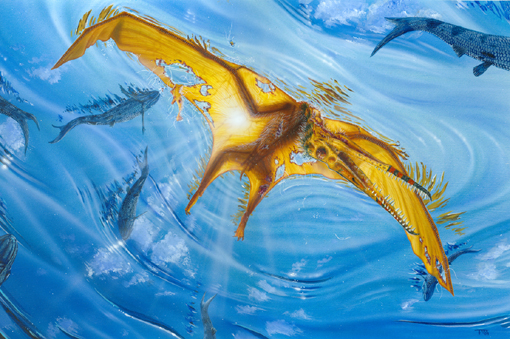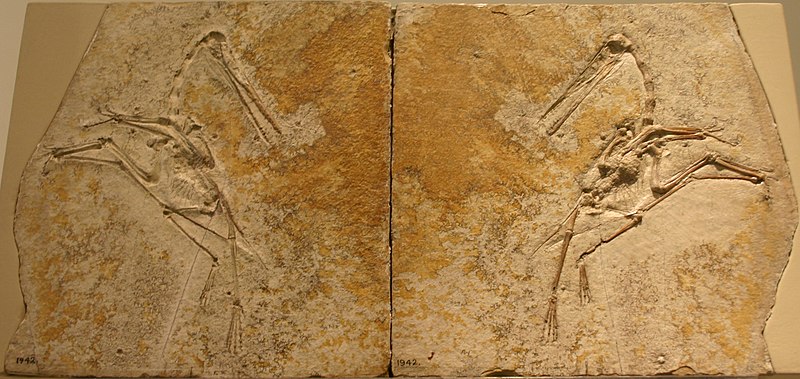[Recent Entries][Archive][Friends][User Info]
| May 23rd, 2012 | |
|---|---|
| 07:59 pm [industrialterro] [Link] |
Pterodactylus Pterodactylus ( The name derives from the Greek words pteron (πτερόν, meaning 'wing') and daktylos (δάκτυλος, meaning 'finger') and refers to the way in which the wing is supported by one large finger. Pterodactylus is known from over 27 fossil specimens, and though most of those are juveniles, many preserve complete skeletons. The discovery of several specimens with well-preserved soft tissue traces has allowed scientists to faithfully reconstruct the life appearance of Pterodactylus. Pterodactylus was a relatively small pterosaur, with an estimated adult wingspan of about 1.5 meters (5 ft) in P. antiquus. Other "species" were once thought to be smaller. However, these smaller specimens have been shown to represent juveniles of Pterodactylus, as well as its contemporary relatives Ctenochasma, Germanodactylus and Gnathosaurus. The skulls of adult Pterodactylus were long and narrow with about 90 large, conical teeth. The teeth extended back from the tips of both jaws, and became smaller farther away from the jaw tips (unlike some relatives, where teeth were absent in the upper jaw tip and were relatively uniform in size). The teeth extended farther back into the jaw than in close relatives, as some were present below the front of the nasoantorbital fenestra, the largest opening in the skull. Unlike related species, the skull and jaws were straight, not curved upwards. A small, hooked beak was present in the very tips of the jaws, with both upper and lower hook no larger than the teeth that surrounded them. The neck was long, and covered in long, bristle-like pycnofibres. A throat pouch extended from about the middle of the lower jaw to the upper part of the neck.ъ Pterodactylus, like related pterosaurs, had a crest on its skull composed mainly of soft tissues. In adult Pterodactylus, this crest extended between the back edge of the antorbital fenestra (the largest opening in the skull) and the back of the skull. The back of the crest extended upward into a backward-curving cone-shaped structure. The crest was composed mainly of long, hardened fibres (twisted together in a spiral pattern inside the conical part of the crest), and covered in scales. In at least one specimen of P. longicollum, the crest had a short bony base, also seen in related pterosaurs like Germanodactylus. Crests have only been found on large, fully adult specimens of Pterodactylus, indicating that this was a display structure and only developed when individuals reached maturity. The wings were long, and the wing membranes appear to have lacked the furry covering of pycnofibres present in some other pterosaurs (such as Pterorhynchus and Jeholopterus). The wing membrane extended between the fingers and toes as webbing, and a uropatagium (secondary membrane between the feet and tail) was present, as well as a propatagium (membrane between the wrist and shoulder). Both the finger and toe claws were covered in keratin sheaths that extended and curved into sharp hooks well beyond their bony cores. Like other pterosaurs (notably Rhamphorhynchus), Pterodactylus specimens can vary considerably based on age or level of maturity. Both the proportions of the limb bones, size and shape of the skull, and size and number of teeth changed as the animals grew. Historically, this has led to various growth stages (including growth stages of related pterosaurs) being mistaken for new species of Pterodactylus. Several detailed studies using various methods to measure growth curves among known specimens have demonstrated that there is actually only one valid Pterodactylus species, P. antiquus. The youngest immature Pterodactylus specimens have a small number of teeth (as few as 15), and the teeth have a relatively broad base. The teeth of older specimens are both narrower and more numerous (up to 90 teeth are present in some specimens). Pterodactylus specimens can be divided into two distinct year classes. In the first year class, the skulls are only 15-45mm in length. The second year class is characterized by skulls 55-95mm long, but still immature. These first two size groups were once classified as juveniles and adults of the species P. kochi, until further study showed that even the supposed "adults" were immature. A third year class is represented by specimens of the "traditional" P. antiquus, as well as a few isolated, large specimens once assigned to P. kochi that overlap P. antiquus in size. However, all specimens in this third year class also show sign of immaturity. Fully mature Pterodactylus specimens remain unknown, or may have been mistakenly classified as a different genus. The distinct year classes of Pterodactylus antiquus specimens show that this species, like the contemporary Rhamphorhynchus muensteri, likely bred seasonally and grew consistently during its lifetime. A new generation of 1st year class P. antiquus would have been produced seasonally, and reached 2nd-year size by the time the next generation hatched, creating distinct 'clumps' of similarly-sized and aged individuals in the fossil record. The smallest size class probably consisted of individuals that had just begun to fly and were less than one year old. The second year class represents individuals one to two years old, and the rare third year class is composed of specimens over two years old. This growth pattern is similar to modern crocodilians, rather than the rapid growth of modern birds. Comparisons between the scleral rings of Pterodactylus antiquus and modern birds and reptiles suggest that it may have been diurnal. This may also indicate niche partitioning with contemporary pterosaurs inferred to be nocturnal, such as Ctenochasma and Rhamphorhynchus. Numerous species have been assigned to Pterodactylus in the years since its discovery. In the first half of the nineteenth century any new pterosaur species would be named Pterodactylus, which thus became a typical "waste-basket taxon". Even after clearly different forms had later been given their own generic name, new species would be created from the very productive late Jurassic German sites, often based on only slightly different material. Around 1980, subsequent revisions by Peter Wellnhofer had reduced the number of recognized species to about half a dozen. Many species assigned to Pterodactylus had been based on juvenile specimens, and subsequently been recognized as immature individuals of other species or genera. By the 1990s it was understood that this was even true for part of the remaining species. P. elegans, for example, was found by numerous studies to be an immature Ctenochasma. Another species of Pterodactylus based on small, immature specimens is P. micronyx. However, it has been difficult to determine exactly of what genus and species P. micronyx might be the juvenile form. Stéphane Jouve, Christopher Bennett and others suggested that it probably belongs either to Gnathosaurus subulatus or one of the Ctenochasma species, but more data and study would be required to determine which one. The only well-known and well-supported species left were P. antiquus and P. kochi. However, most studies since the 1990s have found little reason to separate even these two, and have treated them as synonymous. In 1996, Bennett suggested that the differences between specimens of P. kochi and P. antiquus could be explained by differences in age. In a 2004 paper, Jouve used a different method of analysis and recovered the same result, showing that the "distinctive" features of P. kochi were age-related, and using mathematical comparison to show that the two forms are different growth stages of the same species. A special case is P. longicollum, named by von Meyer in 1854, based on a large specimen with a long neck and fewer teeth. Many researchers, including David Unwin, have found P. longicollum to be distinct from P. kochi and P. antiquus. Unwin found P. longicollum to be closer to Germanodactylus and therefore requiring a new genus name. It has sometimes been placed in the genus Diopecephalus because Harry Govier Seeley based this genus partly on the P. longicollum material. However, it was shown by Bennett that the type specimen later designated for Diopecephalus was a fossil belonging to P. kochi, and no longer thought to be separate from Pterodactylus. Diopecephalus is therefore a synonym of Pterodactylus, and as such is unavailable for use as a new genus for "P." longicollum.
Репродукции (1, 2, 3, 4, 5, 6, 7, 8):
Размеры тела в сравнении с человеком (серым показаны гипотетические размеры взрослой особи, зелёным - размеры найденных сеголетков):
Ископаемые останки (1, 2, 3, 4, 5):
Tags: Вымершие рептилии, Юра, авеметатарзалии, архозавроморфы, архозавры, диапсиды, ктенохазматоидеи, монофенестраты, птеродактили, птерозавры |













